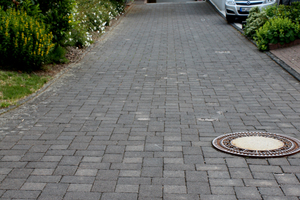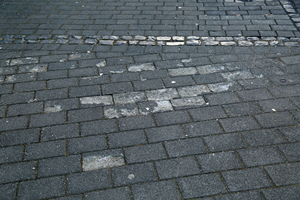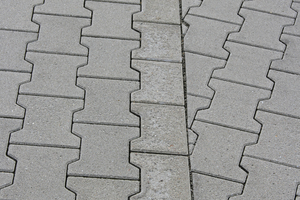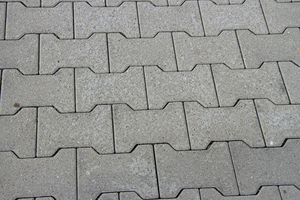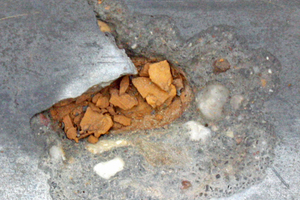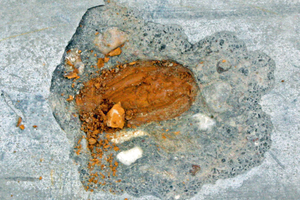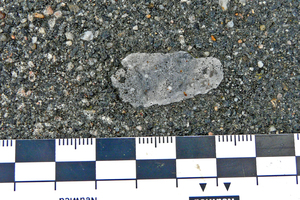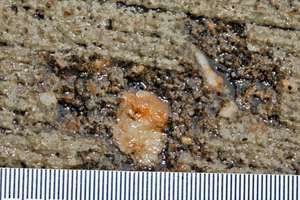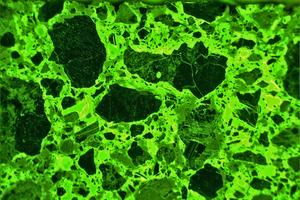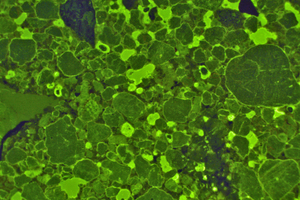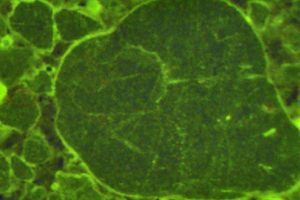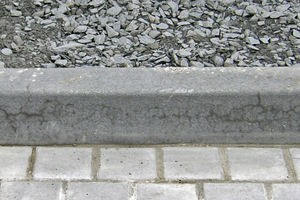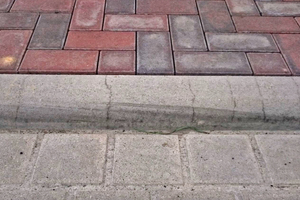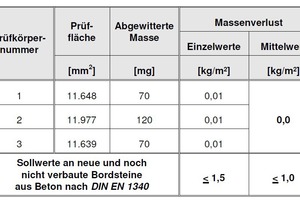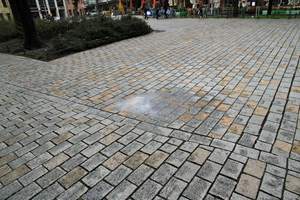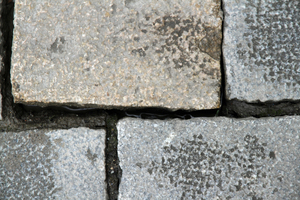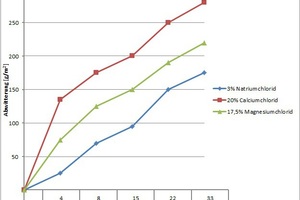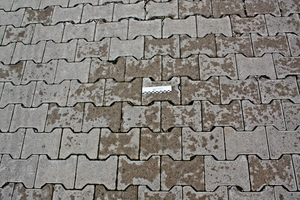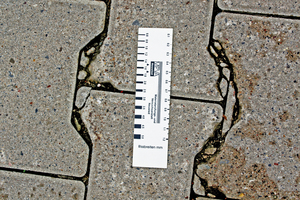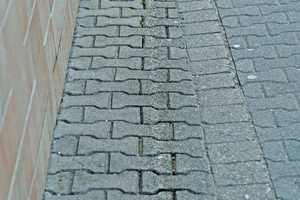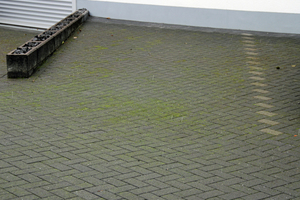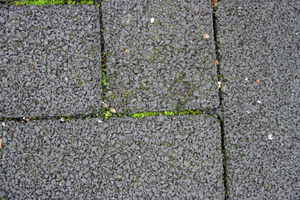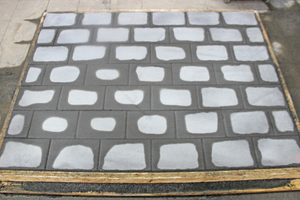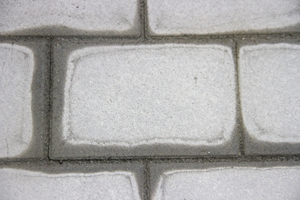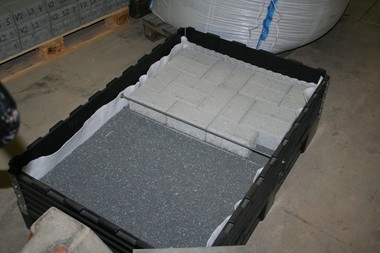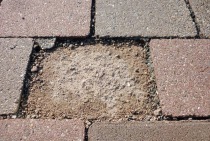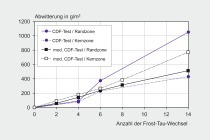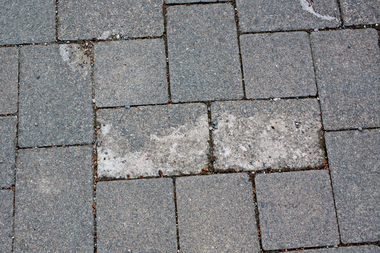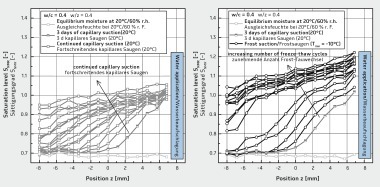Assessment of frost and freeze-thaw damage to concrete pavers (Part 1)
This article deals with the technological assessment of paved surfaces where concrete pavers were damaged due to freeze-thaw impact. Part 1 concentrates on the test and assessment methods available for identifying root causes of the damage as well as for determining appropriate remedial actions.
High weather resistance of concrete pavers is crucial wherever paved surfaces are exposed to frequent freeze-thaw cycles. In this respect, it should be noted that the climatic conditions prevailing in “warm inner-city areas” (with only a few frost days) and in the high mountains (with only a few days above the frost threshold) are usually less critical than in areas continuously exposed to freeze-thaw impact. For instance, the increased susceptibility to damage of car wash areas is due to the large number of freeze-thaw cycles.
In Germany, concrete pavers with increased weather resistance (Class 3 in accordance with DIN EN 338) must be used for paved surfaces owing to the prevailing climatic conditions. Yet damage such as concrete spalling is often found in paved areas and frequently gives rise to legal disputes (see Fig. 1).
Against this backdrop, this article primarily deals with the technological assessment of paved surfaces where concrete pavers were damaged due to freeze-thaw impact. In so doing, this article concentrates on the test and assessment methods available for identifying root causes of the damage as well as for determining appropriate remedial actions. Further information regarding the damage mechanisms and the assessment of samples taken from paved surfaces is provided in [3].
1 Appearance
1.1 Damage patterns
Damage caused by freeze/de-icing salt impact on paved surfaces can become visible in a wide variety of patterns, including locally restricted or widespread cement paste scaling or punctiform pop-outs on top of individual aggregate particles.
Widespread cement paste scaling is the most common phenomenon usually found after freeze-thaw impact on concrete pavers, but the scaling rate can vary strongly (see Figs. 1 and 2). The same is true for the number of affected paving stones even if items from a single production batch are installed. In many cases, only isolated pavers or small areas are affected, whereas in others, almost all pavers of a large paved surface show signs of damage.
Other phenomena frequently seen besides more or less extensive scaling include locally restricted patterns also referred to as pop-outs on the paver surface. This type of damage usually starts from the near-surface aggregate particles of the face mix and continues in the direction of the cement paste (see Fig. 3).
More often than not, even experts in the field attribute this type of scaling to the use of inappropriate, and thus “defective”, aggregate particles in the event of a complaint without carrying out further tests.
Upon closer inspection, the notion of aggregate particles with insufficient weather resistance causing the damage is frequently proved to be incorrect. Although aggregate particles susceptible to disintegration are often found in the center of such scaling patterns (see Fig. 3), entirely intact particles with a dense structure and high freeze-thaw resistance (Fig. 4) are identified much more frequently in the center of such phenomena.
In the cases shown in Fig. 4, cement paste scaling (so-called pop-outs) occurred not because of an insufficient freeze-thaw resistance of the aggregates but due to the following interacting effects:
Dense aggregate particles (appearing in a dark shade in Fig. 5) are significantly less porous than the cement paste (i.e. the green zones in Fig. 5). Thus, the water freezing in the transition zone between the cement paste and the aggregates cannot expand in the direction of the aggregate particle (because of the very small available space for expansion) and thus blows off the cement paste that forms the top layer.
Owing to the low water absorption capacity of the aggregate particles, a thin cement paste layer with increased porosity (see the red arrows in Fig. 6), higher water absorption capacity and reduced weather resistance often forms in the contact zone between the dense aggregate particles and the paste.
We thus find that, in the above cases, cement paste scaling was caused by insufficient freeze-thaw resistance of the cement paste in conjunction with very dense aggregate particles rather than by inferior aggregate quality.
Yet the quality of the face mix is not the only factor that contributes to the onset of frost and freeze-thaw damage to concrete block pavements; the weather resistance of the mineral aggregates used in the concrete is just as important in this regard. For instance, cement paste scaling may also occur on top of individual aggregate particles (see the pop-out in Fig. 7) if these exhibit an insufficient weather resistance.
When assessing related damage patterns, we should bear in mind that neither the aggregate nor the concrete produced with it needs to be free from scaling according to the applicable standards (see also Section 1.2 in the second part of this article and Section 1 in [3]).
1.2 Cracks
Clients often submit product deficiency complaints on the grounds of reduced weather resistance if the product surface exhibits cracking patterns. In this respect, the weather resistance of curbs and pavers can indeed be compromised by the occurrence of cracks, but this need not necessarily be the case. Accordingly, cracks such as shown in Fig. 8, for instance, not necessarily constitute a technical defect.
As demonstrated by the results of the freeze-thaw tests performed on cracked curbstones, purely superficial cracking as shown on the right-hand side of Fig. 8 does not necessarily make the curbs less durable or serviceable. Rather, such cracks are often mere visual imperfections.
Cracks become critical only if they transport water so that the expansion pressure of the freezing water can act on the face mix via the crack edges. Cracks occurring in conjunction with additional small voids between the face and the core mix also often lead to a reduced freeze-thaw resistance of the product.
2 Causes of damage
2.1 Influence of standard of workmanship
Experience proves that the standard of workmanship of the concrete block pavement has only little influence on the weather resistance of products. Rather, such a reduction is mainly due to the installation of a subbase and/or bedding with insufficient drainage capacity.
The risk of frost and freeze-thaw damage to concrete block pavements increases if the pavers are laid on a subbase with insufficient permeability, which is associated with water penetration into the structure. This water is then entrapped and cannot drain into the substructure properly (see Fig. 9).
As a result, the core mix and, potentially, the face mix will be saturated with water, which also fills at least a certain portion of the expansion space within the concrete pore system. The greater the proportion of water-filled pores in the pavers, the higher the risk for frost and/or freeze-thaw damage to occur.
2.2 Influence of use
Besides the standard of workmanship with which the concrete pavement was installed (with respect to its drainage capacity) and the quality of the pavers, the type and intensity of use can also influence the weather resistance of the products the paved surface consists of. The following two points are considered to be the most relevant in this regard:
Influence of de-icing service
Influence of pavement cleaning
Furthermore, any factors causing high water saturation of the products installed in the paved area will also have an influence on the frost or freeze-thaw resistance of the pavement.
Applicable standards and guidelines also refer to the relationship between the appearance of areas covered with concrete pavers and the duration and intensity of their use. The FGSV M FP Code of Practice, for instance, states that signs of wear and tear will inevitably occur even if the surface is used as intended. In the event of a dispute, officially appointed experts providing their opinion will thus have to judge if the identified level of scaling is commensurate with the age, ambient conditions and use of the concrete block pavement (see [3] for more detailed information).
These considerations show that, in response to relevant complaints, the expert is also to assess the amount of scaling that can be considered to be in line with expectations with a view to the actual use whilst considering previous weather impact on the pavement.Only if the actual scaling rate exceeds the “usual level” under the given ambient conditions can surface scaling be classed as a defect from a technical standpoint.
2.2.1 De-icing service
In the winter season, a wide range of de-icing chemicals is used for ensuring safe pedestrian access to concrete block pavements. The most important de-icing agent continues to be sodium chloride although there is a marked trend towards applying other agents such as potassium, calcium and magnesium chlorides.
There is generally no reason why these agents should not be used. However, DIN EN 1338 specifies that the standard verification of the freeze-thaw resistance (such as for concrete pavers) be carried out for sodium chloride rather than calcium or magnesium chloride.
Against this backdrop, we should take note of tests conducted at TU Munich according to which the scaling rate of concrete pavers was found to be 30% and 60% higher in the freeze-thaw tests (slab tests including 28 freeze-thaw cycles) for magnesium and calcium chloride, respectively, compared to using sodium chloride as a de-icing agent (see Fig. 10).
We thus find that concrete block pavements fulfilling the requirements stipulated in the standard by reaching, for instance, a mean scaling rate of 900 g/m2 during the laboratory freeze-thaw test using sodium chloride fail to exhibit sufficient weather resistance as defined in applicable standards if magnesium chloride (with a calculated scaling rate of 1,170 g/m2) or calcium chloride (calculated scaling rate of 1,440 g/m2) is used for de-icing.
As demonstrated by the above tests, the suitability testing of concrete pavers must include exposure to the specific de-icing agent used if the pavers are to also exhibit sufficient freeze-thaw resistance to de-icing agents other than sodium chloride.
Yet the situation is even more complex in applications beyond road construction, such as in wastewater treatment plants, airports or similar projects because other, additional types of de-icing agent are sometimes used, including:
Alcoholic de-icing agents (containing ethylene glycol, for instance)
Urea or urethane-containing de-icing agents
De-icing agents such as Safeway, especially at airports.
If one of the above de-icing chemicals is used, we cannot necessarily assume transferability of the standard verification of an increased freeze-thaw resistance according to DIN EN 1338 to the actual freeze-thaw impact caused by these agents.
Conventional de-icing agents are often replaced with more modern de-icing agents particularly in heavily frequented paved areas such as railway stations, parking facilities next to supermarkets, or pedestrian precincts.
After only a few years of use, many of these surfaces will be damaged although the installed concrete or natural stone products should provide sufficient freeze-thaw resistance according to the related test certificates. Moreover, these products were successfully installed in many other properties without showing signs of damage. In terms of its appearance, such damage cannot be distinguished from “typical” freeze-thaw damage so that liability for this damage is usually attributed to the construction materials producer although the damage may be due to the application of particularly aggressive de-icing agents.
This is why, in the event of a dispute, experts need to clarify if one of the above-mentioned “modern” de-icing agents was applied to the concrete pavement. If the answer to this question is “Yes”, it should be verified if the concrete block producer had been aware of the intent to use these de-icing agents prior to delivery of its products.
This means that experts need to verify the contractual situation before identifying “responsibilities”, asking questions such as: Did the specification contain any indication of the use of such de-icing agents? Were these particular agents used without consultation with the construction materials supplier, or did the latter approve their use? Who was responsible for conducting the initial tests for verifying freeze-thaw resistance of the products (not tested with sodium chloride)? Was there a separate agreement in place at all for initial testing?
Experience shows that the products used for the installation of concrete block pavements are normally not subjected to separate initial tests. Nor would any party to the contract be informed of the intended application of specific de-icing agents at this stage. Should the planner have coordinated and forwarded this information?
2.2.2 Moisture content of paved surface
We can identify the influence of the water absorption by the face mix on the weather resistance of the products already on the basis of the applicable standard limiting the water absorption of the face mix to less than 6 percent by mass in the declaration of Class 2 (Label B) included in Tab. 4.1 of DIN EN 1338.
This limit imposed on the water absorption of the facing layer can be explained by the fact that no major expansion pressure can develop in the face mix during the freezing of water in the absence of significant amounts of water penetrating into the facing layer (see [3]). Nor will significant frost damage to the facing layer of the concrete pavers occur in this case.
Note: The above-mentioned value of 6 m% is purely indicative, which is why it provides no basis for properly assessing the freeze-thaw resistance of concrete pavers.
Higher water absorption leads to a greater degree of water saturation in the facing layer of concrete pavements, thus increasing the risk for frost or freeze-thaw damage to occur. It is exactly for this reason that the durability of so-called “water guzzlers” should be questioned.
The notion of “water guzzlers” refers to concrete block pavements installed in an “exceedingly dry” process or with “too little compaction energy” that absorb penetrating water very quickly (strong capillary suction) and release this water very slowly (slow drying behavior (Fig. 11)). Although the durability of such block pavements need not necessarily be compromised, the risk of freeze-thaw damage increases for the above-mentioned reasons even if the concrete recipes used for the pavers conform to applicable codes and standards.
The correlation between the water saturation of the pavers’ facing layer and the risk of frost or freeze-thaw damage also means that concrete block pavements with greater use-related water exposure will sustain more pronounced frost and/or freeze-thaw damage. This is why frost or freeze-thaw damage will predominantly occur in areas subject to significant water exposure and thus comparatively high water saturation, such as in the area of drip edges of structural components (see Fig. 12).
2.2.3 Cleaning
Concrete block pavements must undergo regular cleaning in order to retain their specified durability. Joints need to be refilled with appropriate material after cleaning.
Note: References [2] und [3] refer in more detail to damage attributable to inappropriate cleaning or insufficient joint filling.
Both the use of water-retaining jointing materials (see [2]) and the formation of green deposits in the joints adversely affect the block pavement’s moisture level. This is why heavily soiled joints filled with green deposits (see Fig. 13) cause a significant slowdown of the drying process of the paved surface (see Fig. 14).
3 Outlook
The first part of this article dealt with the different patterns associated with freeze-thaw damage, the impact of cracks occurring in products, and the influence of installation and use on the onset of damage. Its second part will concentrate on the expert assessment of freeze-thaw damage in relation to specific projects. More specifically, it will cover the following points:
Possible methods for verifying the freeze-thaw resistance of products
Permissible scaling rates on samples taken from installed pavements
Assessing the weather resistance of installed products and considering specific factors relevant to evaluating products with particular visual appeal.

